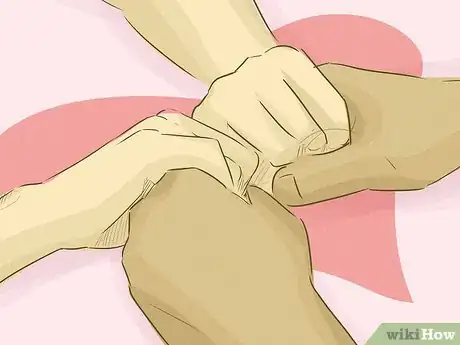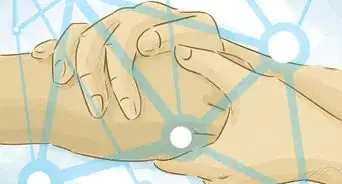This article was co-authored by Alyssa Chang. Alyssa Chang is a nutrition coach and trainer, based in the San Francisco Bay Area. She uses her extensive background in brain-based neuroscience to work with clients on improving their connections with their brain and body to heal, reach goals, and move pain-free. She holds a BS in Kinesiology and Exercise, Nutrition and Wellness from the California State University, East Bay and is certified in Precision Nutrition, Z-health Performance and is certified by the National Council for Strength and Fitness.
wikiHow marks an article as reader-approved once it receives enough positive feedback. In this case, 94% of readers who voted found the article helpful, earning it our reader-approved status.
This article has been viewed 71,469 times.
Self-acceptance is the ability to accept yourself as you are instead of how you wish you were.[1] It is the basis of much of our happiness in life, yet for many it is easier said than done. Getting through life happily and peacefully requires us to understand the balance of positive and negative and work towards accepting anything that life may throw our way.
Steps
Becoming More Self-Aware
-
1Recognize your thoughts and feelings. The goal of this is to be aware of your thoughts, self-judgement, pain, and any other feelings that may be hindering self-growth. This form of self-assessment is a relaxed awareness of your thoughts, somewhere in between a state of distraction and extreme focus.[2]
- Stand in front of a mirror as stripped down as possible (no make-up, no jewelry) and notice what thoughts are present. Categorize them (positive, negative, different feelings, etc).
- Practice anywhere from 5-30 minutes per day, taking note of what thoughts are often repeated.
-
2Welcome all of your feelings--good and bad. You don't have to like everything that you notice about yourself. Self-acceptance is simply recognizing your thoughts in order to figure out how to improve or change them.[3] Once you are aware of your feelings, don't try to push them away--welcome them instead of hiding them.
- Think about negative feelings as a hurt person. How would you treat a person in need? Treat your feelings that way. Welcome them to stay for a while and then turn that negativity into a learning opportunity.
- Ask yourself, "what can I learn from this negative thought?"
- If the thought is positive, don't run from it. Accept it and know that you are deserving of feeling good about yourself.
Advertisement -
3Separate yourself from your emotions through visualization. You are not your emotions. Just because you feel angry or sad one day, doesn't make anger or sadness a part of who you are.
- When you feel a negative emotion taking shape, use visualization techniques to stop it from weighing you down.
- Imagine your emotions as balloons which have the ability to just float away. Know that you have the option of when you will release that balloon, and that it has no control over you (and neither do your negative thoughts).
Ridding Yourself of Negativity
-
1Be forgiving. Forgiving yourself doesn't mean that you excuse or pardon misbehavior on your part. It simply means that you take an honest look at your past, admit your transgressions, and keep moving forward without beating yourself up. To err is human, so forgive yourself and move forward.
- The first step in forgiveness is to recognize the wrong. Have you hurt someone else? Have you hurt yourself? Did you fail yourself?
- Correct the problem. Maybe it's something as simple as apologizing to the one you hurt (including yourself). Or maybe it involves changing your actions to show someone you've hurt how you recognize your part in their pain.
-
2Practice PERT. When you start to beat yourself up, use Positive Emotion Refocusing Technique. For 45 seconds, close your eyes, breathe deeply, and imagine a peaceful place or someone you love. Tap into the positive emotions that surround you, and in your peaceful state, ask yourself what you can do to make yourself feel better.
- Use PERT techniques at the very moment that when negative thoughts begin. It will assist in changing your perception of your thoughts and will either stop or reduce negativity and stress.
-
3Stop rating yourself. Unfortunately we live in a society where we constantly compare ourselves to others. We judge ourselves on how smart, pretty, thin, or successful we are in comparison to others.
- The first step is to notice how often it occurs and how you feel when that occurs. It often causes a great deal of pain for many.
- Remember, that comparisons put the focus on the wrong person--you can only control your actions, not anyone else's. You are too special to be compared to anyone else--your individual gifts and abilities are what make you unique and you.[4]
-
4Turn negatives to positives. Thoughts are incredibly powerful. It only takes 30 seconds of thinking of a negative thought for it to become part of our subconscious. But you can train your brain to learn to control what you allow into your life.[5]
- The easiest way to deal with negative thoughts is to simply ignore them. Meditation can often help you to train your mind to release negativity instead of holding onto it.
- Surround yourself with positivity in order to feel happier. Hang out with people who are optimistic and hopeful, and pick up hobbies that you enjoy.
-
5Use positive self-talk. Dwelling on negativity only fuels unhappiness. Therefore it's important to train your brain to not only recognize the negative, but to also change it to a positive.[6]
- For example, instead of saying, "I can't do this," say something like, "I can do this and I will do this." Instead of saying, "It's not my day," try saying instead, "I am in control of this day."
- Use writing to change your thoughts by creating a gratitude journal or writing a gratitude letter.
Building Yourself Up
-
1Continue growing. A lack of self-acceptance shouldn’t be an excuse to avoid growing. On the contrary, you should accept the bumps in the road as well as certain aspects of your personality as you’re developing towards a better you.
- Surround yourself with successful people. Like begets like, so surround yourself with people who will continue to inspire you and push you to do better in life.
- Determine what you're good at. Focus on growing in a subject that you both know and enjoy. Get a deeper understanding of a subject and maybe even become an expert or a mentor to others.
-
2Be flexible. The more rigid you are, the less you’ll be open to developing and growing as a person. Think of bamboo as it bends across the wind without breaking. If it were rigid and stiff, it would break in two. Pliability allows it to flow effortlessly through the wind as it stays intact.
- Get rid of irrational fears. Often, people are afraid to change simply because they fear the unknown. Letting go of this fear can help you to "go with the flow" and accept things as they come.
- Don't be afraid to change your goals. Part of being flexible is knowing when it is time to change your goals. Do you need to be more specific, make it more relevant, allow more time? Be willing to adapt as needed.
-
3Keep your power. Our images of ourselves are created based on what others have told us about ourselves or comparisons we make against others. You’ll inevitably come across others who will insult you or attempt to hurt you. Allowing their comments to have an effect on you is giving them power. It takes practice, but it’s certainly possibly to shrug off the comments of others without personalizing them. Don’t compete with anybody else. Their journey in life is much different than yours.
- Instead, compare yourself to yourself. Are you a stronger, wiser, healthier, more loving person today than you were a year ago? Focus on growing and developing yourself.
- Set goals and track them so you know whether you are on track to becoming a better you. Allow your progress to determine your power, not others.
-
4Talk to someone. Sometimes it is easier to sort through the mess in our heads when we can vocalize it to a trusted source. Talking to a friend, co-worker, spouse, or professional can help to not only rid yourself of negative thoughts, but to see the positive that others see in you.
- Professionals such as licensed professional counselors, psychologists, and life coaches can assist you in practicing skills to help you build your self-acceptance over time.
Expert Q&A
-
QuestionHow do I make the most out of my time?
 Alyssa ChangAlyssa Chang is a nutrition coach and trainer, based in the San Francisco Bay Area. She uses her extensive background in brain-based neuroscience to work with clients on improving their connections with their brain and body to heal, reach goals, and move pain-free. She holds a BS in Kinesiology and Exercise, Nutrition and Wellness from the California State University, East Bay and is certified in Precision Nutrition, Z-health Performance and is certified by the National Council for Strength and Fitness.
Alyssa ChangAlyssa Chang is a nutrition coach and trainer, based in the San Francisco Bay Area. She uses her extensive background in brain-based neuroscience to work with clients on improving their connections with their brain and body to heal, reach goals, and move pain-free. She holds a BS in Kinesiology and Exercise, Nutrition and Wellness from the California State University, East Bay and is certified in Precision Nutrition, Z-health Performance and is certified by the National Council for Strength and Fitness.
Wellness Coach & Personal Trainer Determine where your time goes. Sometimes we spend too much time on items and events that add little to no substance to our lives: television, social media, bar hopping, etc. Make sure your spare time is spent on something that will nurture your mind and spirit, not hinder you from growing.
Determine where your time goes. Sometimes we spend too much time on items and events that add little to no substance to our lives: television, social media, bar hopping, etc. Make sure your spare time is spent on something that will nurture your mind and spirit, not hinder you from growing.
References
- ↑ http://www.oprah.com/spirit/How-Self-Acceptance-Can-Crack-Open-Your-Life
- ↑ http://zenhabits.net/acceptance-techniques/
- ↑ http://www.eruptingmind.com/how-to-love-and-accept-yourself-self-acceptance/
- ↑ https://www.becomingminimalist.com/compare-less/
- ↑ http://www.inc.com/rhett-power/2-ways-to-turn-negative-into-positive.html
- ↑ http://www.helpguide.org/articles/emotional-health/cultivating-happiness.htm









































































